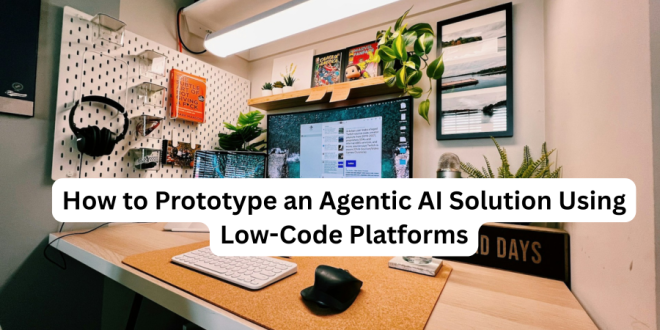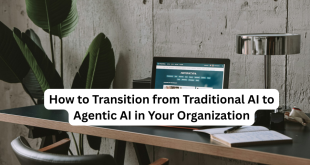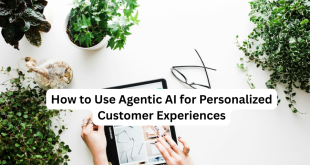Agentic AI—autonomous systems that make decisions and execute tasks with minimal human input—is revolutionizing industries from healthcare to logistics. But building such a system might sound daunting, especially if you’re not a coding expert. The good news? Low-code platforms make it easier than ever to prototype agentic AI solutions quickly and affordably. In this blog, we’ll walk you through the steps to create your own agentic AI prototype using low-code tools, no deep programming skills required.
Why Low-Code for Agentic AI?
Low-code platforms simplify development by offering drag-and-drop interfaces, pre-built templates, and integrations with AI services. They allow businesses, startups, or even hobbyists to experiment with agentic AI without investing heavily in custom coding. According to Gartner, by 2025, 70% of new enterprise applications will be built using low-code platforms, making them a perfect entry point for prototyping autonomous AI agents.
Here’s a step-by-step guide to get you started.
Step 1: Define Your Agentic AI Use Case
Before diving into any platform, clarify what your AI agent will do. Agentic AI excels at tasks requiring autonomy, like automating customer support, optimizing supply chains, or managing smart home devices. For this guide, let’s assume you’re prototyping an AI agent to automate responses to customer inquiries for a small e-commerce business.
Action Item: Write down your use case. For example: “An AI agent that analyzes customer emails, categorizes them (e.g., refunds, product inquiries), and sends personalized replies.”
Step 2: Choose a Low-Code Platform
Several low-code platforms support AI integrations, making them ideal for agentic AI prototypes. Here are three popular options:
- Microsoft Power Apps: Offers seamless integration with Azure AI services, like natural language processing (NLP) for text analysis.
- Google Cloud’s AppSheet with Vertex AI: Combines app-building with Google’s powerful AI models for tasks like text generation or sentiment analysis.
- Bubble with API Integrations: A flexible low-code tool that connects to external AI APIs, such as OpenAI or Hugging Face, for advanced functionality.
For our e-commerce example, we’ll use Microsoft Power Apps because of its user-friendly interface and built-in AI Builder, which supports custom AI models.
Action Item: Sign up for a free trial of Microsoft Power Apps (or your chosen platform) and explore its AI capabilities.
Step 3: Design the Workflow for Your AI Agent
Agentic AI thrives on clear workflows. Map out how your AI agent will operate. For our customer inquiry agent:
- Input: Receive customer emails via an integrated email service (e.g., Outlook).
- Processing: Use NLP to analyze email content and categorize it (e.g., refund request, product question).
- Decision: Select an appropriate response template or generate a custom reply.
- Action: Send the reply and log the interaction for future reference.
Low-code platforms like Power Apps let you visualize this workflow using flowcharts or drag-and-drop components.
Action Item: Sketch your workflow on paper or use a tool like Miro. In Power Apps, create a new app and select the “Canvas” or “Model-driven” app type to start building.
Step 4: Build the AI Model
Most low-code platforms offer pre-built AI models or let you train custom ones. In Power Apps, the AI Builder feature simplifies this process. For our example:
- Select a Model: Choose the “Text Classification” model to categorize customer emails based on intent (e.g., refund, inquiry).
- Train the Model: Upload sample customer emails (e.g., 50-100 examples) and label them by category. AI Builder uses this data to learn patterns.
- Test the Model: Input test emails to ensure the model accurately identifies intents.
For generating replies, integrate with Azure’s Language Service (available via Power Automate) to create natural, context-aware responses.
Action Item: In Power Apps, navigate to AI Builder, create a text classification model, and train it with sample data. Test its accuracy before proceeding.
Step 5: Automate the Workflow with Low-Code Tools
Now, connect your AI model to the rest of the system. In Power Apps, use Power Automate to create an automated flow:
- Trigger: Set up a trigger to detect new emails in your Outlook inbox.
- Analyze: Pass the email content to the AI Builder model to classify the intent.
- Decide: Use conditional logic (e.g., “If intent = refund, select refund template”).
- Respond: Generate a reply using Azure Language Service or a pre-written template and send it via Outlook.
- Log: Save the interaction to a database (e.g., Microsoft Dataverse) for tracking.
Power Automate’s drag-and-drop interface makes this process intuitive, even for beginners.
Action Item: In Power Automate, create a new flow, add the above steps, and test it with a sample email.
Step 6: Test and Iterate
Run your prototype with real or simulated data. For our e-commerce agent, send test emails with different inquiries and check if the AI categorizes and responds correctly. Look for issues like misclassified intents or unnatural replies.
Gather feedback from stakeholders (e.g., your team or a small customer group) and refine the model. Low-code platforms make iteration easy—you can tweak workflows or retrain AI models without rewriting code.
Action Item: Test your prototype with at least 10-20 emails. Adjust the AI model or workflow based on errors or feedback.
Step 7: Deploy and Monitor
Once satisfied, deploy your prototype for limited use (e.g., handle a subset of customer emails). Power Apps lets you share apps with your team or embed them in existing systems like Microsoft Teams. Monitor performance using built-in analytics to track response accuracy and customer satisfaction.
For long-term use, consider scaling with additional features, like integrating with a CRM or adding multilingual support.
Action Item: Deploy your app in Power Apps, share it with a small user group, and review analytics after one week.
Tips for Success
- Start Small: Focus on a single use case to avoid complexity.
- Use Pre-Built Templates: Platforms like Power Apps offer templates to accelerate development.
- Leverage Community Resources: Explore tutorials on YouTube or forums like Microsoft’s Power Apps Community.
- Stay Ethical: Ensure your AI agent respects customer privacy and complies with regulations like GDPR.
Why Prototype with Low-Code?
Prototyping with low-code platforms like Microsoft Power Apps lets you test agentic AI ideas without heavy investment. In just a few hours, you can build a functional AI agent that automates real-world tasks, like responding to customer inquiries. As agentic AI grows—Gartner predicts 15% of work decisions will be autonomous by 2028—low-code tools empower anyone to join the revolution
 UBUCH ubuch | Honest Tech Reviews & Tutorials for Everyone
UBUCH ubuch | Honest Tech Reviews & Tutorials for Everyone




